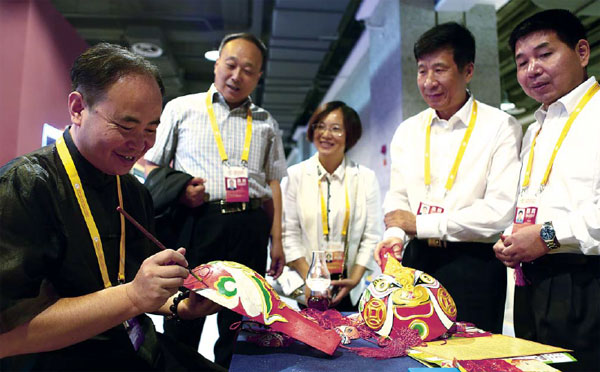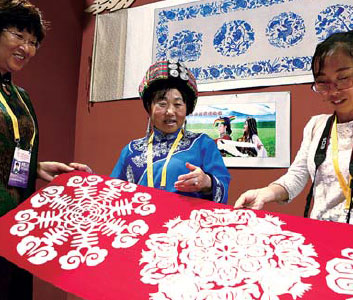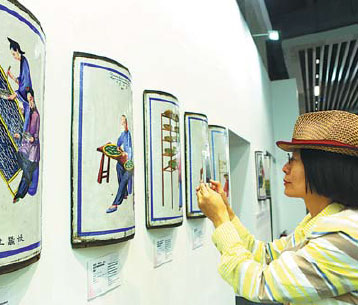News
A cultural bridge between East and West
Updated: 2016-10-10By Song Mengxing ( China Daily )
Event attracts delegations from 85 countries to build a modern path to prosperity, Song Mengxing reports.
The Silk Road (Dunhuang) International Cultural Expo works as an important platform for cultural cooperation and communication among countries and regions to promote human progress, participants at the expo said.
The first expo, which opened on Sept 20 in Gansu province in Northwest China, attracted 95 delegations from 85 countries and five international organizations. It included a high-level conference, forums, cultural exhibitions and performances to display cultural products and promote cultural cooperation, the event's organizers said.
"The expo is an international grand event of Silk Road culture communication as the theme and aims to promote the Silk Road spirit," Wang Sanyun, Party chief of Gansu, said at the opening ceremony.
Such spirit comprises peace and cooperation, opening-up and inclusiveness, mutual learning and win-win relations, according to Wang.

He said the expo would advance integration of cultures and attitudes from regions along the Silk Road and help development in those regions.
Minister of Culture Luo Shugang said that the expo would provide new ways for countries along the Silk Road to further their cultural communication and cooperation to generate mutual benefits.
The event helps people from different countries and regions to better know each other and offer cultural support to the development of the Silk Road Economic Belt, which is part of the Belt and Road Initiative proposed by President Xi Jinping in 2013, Luo said.
He Yiting, executive vicepresident at the Party School of the Central Committee of Communist Party of China, said that the historic Silk Road connected Chinese, Mesopotamia, Mediterranean, Indian and Egyptian cultures and because of the Silk Road and the Maritime Silk Road, different cultures progressed and prospered together.
Opening-up, inclusiveness and mutual learning are the impetus for the Chinese people to make progress and also one of the foundations for the progress of human civilization, He said.
Chinese author Mo Yan, who won the Nobel Prize in literature in 2012, said at a forum that the essential aim of cultural communication should be innovation, and that just copying something is of no significance.
The expo's most important goal is to create cultural forms and artworks based on sufficient communication and discussion, Mo said.
He said he hopes activities at future expos will be more diversified and reflect the history of the Silk Road as well as past and present Dunhuang cultures.
The city of Dunhuang, which was a major stop on the ancient Silk Road and is best known for the Mogao Caves, hosted the expo.
This expo's cultural exhibitions showcased some 8,500 exhibits from more than 60 countries, ranging from cultural relics, fine arts and photography, creative designs to intangible heritage.
France, the expo's guest of honor, brought to the event nearly 400 artworks, including oil paintings and sketches done by noted artists.
More than 1,300 domestic and foreign performers offered diverse performances including dances, acrobatics and concerts.
The Ministry of Culture signed cooperation plans with cultural departments from Jordan and Bulgaria. Gansu signed 18 cooperation agreements with government agencies and companies from related countries as well as international organizations. The Dunhuang Declaration was launched at the expo.
It plans paths and directions for cultural cooperation among countries and regions along the Silk Road and lays a cultural foundation for development of the Belt and Road Initiative, the event's organizers said.
The declaration was one of the most important and influential achievements of the expo, they added. Gansu has geographical, cultural and policy advantages for hosting the expo, local officials said.
The province in the hinterland of northwestern China borders regions such as Shaanxi, Sichuan and Qinghai provinces and the Ningxia Hui autonomous region. It is a comprehensive transportation hub involving railways, highways, air routes and waterways, and connects East Asia to Central and West Asia and Europe.
The province was a strategic passageway and trading region along the ancient Silk Road, which extends 1,600 kilometers through the province, the officials said. They said Gansu helped bridge Chinese and Western cultures in ancient times and has played an irreplaceable role in promoting communication between the East and West.
The province also has huge potential as the central government has provided supportive policies to Gansu in recent years and agreed on construction of some national-level strategic areas, including the Lanzhou New Area.
Implementation of the Belt and Road Initiative offers Gansu, which is located in the golden area of the Silk Road Economic Belt, a great development opportunity and makes it an important opening-up region in the country.
The province said it is confident that in five years it can make the expo a world-class and widely influential cultural exposition, which can promote communication and understanding among countries and regions along the Silk Road.
The Gansu Provincial Information Office contributed to this story.
Contact the writer at songmengxing@chinadaily.com
|
Artist Zhang Xing (left) shows visitors the art of Mashao facial masks, a folk culture handicraft from Shaanxi province, at the expo. Photos By Mao Jian / For China Daily |
|
An intangible cultural heritage item in China, embroidery from Qiang minorities is one of the highlights at the expo. |
|
A visitor takes photos of the painting exhibits during the event. |
(China Daily 09/30/2016 page24)





